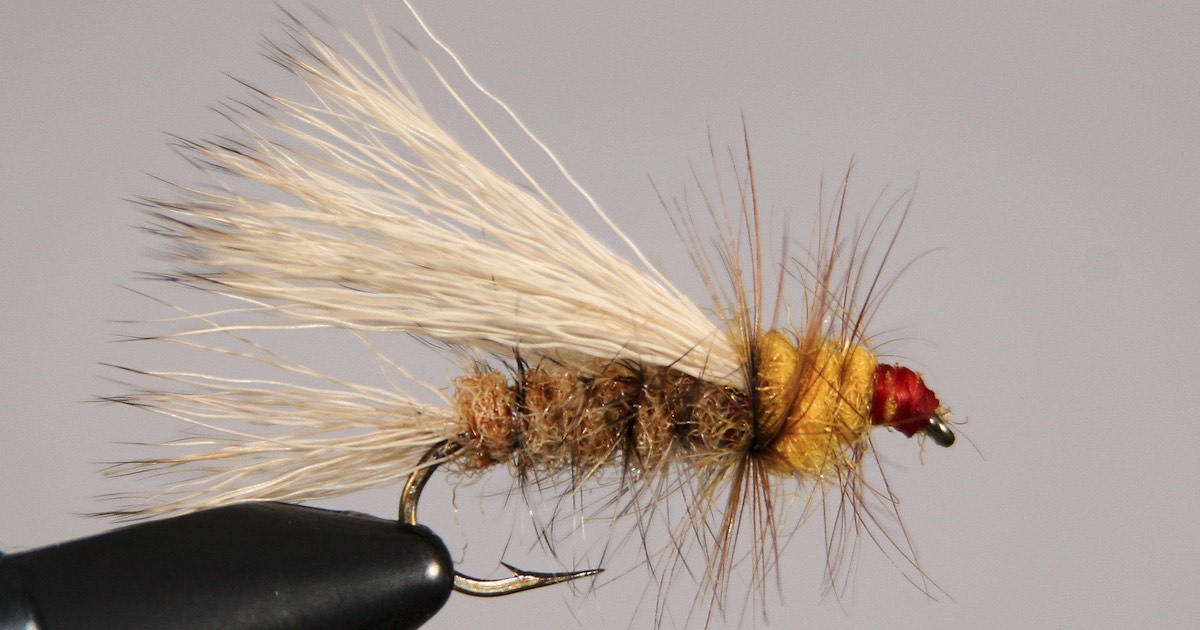
May is the time of year on Vancouver Island when things really get going where insect hatches are concerned—almost everything is coming alive. Two of the greatest hatches are happening now: the March Brown mayfly hatch and the golden stonefly hatch.
The March Brown Nymph
The March Brown hatch is prolific and lasts many weeks, from about mid-April through to June. While fishing an adult imitation on the surface is a ton of fun, on the cooler days and in the morning fish the nymph dead drift.
- Hook: Mustad 94840 #12 – 14
- Thread: Black monocord
- Tail: Two or three strands or black moose mane Black monocord
- Rib: Black monocord
- Abdomen: Chocolate brown floss
- Thorax: Peacock herl
- Shellback: Pheasant tail
- Hackle: Furnace hackle
Tying Steps
- Wrap the monocord to the hook butt and tie in the 3 moose mane hairs, leaving a tail about shank length.
- Tie in a length of separate black monocord for the rib and then a length of floss.
- Wrap the floss half way up the hook shank, tapering the abdomen thicker towards the eye of the hook. Tie it off, cut, and trim excess.
- Wrap the black monocord forward, forming a nice black rib. Tie it off, and trim excess.
- Tie in the pheasant fibres on the top of the shank.
- Tie in one furnace hackle, tip first.
- Tie in the peacock herl.
- Wrap the herl forward to near the hook eye, forming a thorax. Tie it off, cut, and trim excess.
- Palmer the furnace hackle forward to form the legs. Tie it off, cut, and trim excess.
- Pull the pheasant fibres over the top of the hackle forming a shellback. Tie it off, cut, and trim excess.
- Wrap a tight, small head.
- Whip finish, cut, and trim excess.
The Stimulator
The golden stonefly hatch is short and does not happen on every river on the island. It does occur on the Cowichan. It only lasts a few weeks, but if you are out there when it does, it pays to have a good imitation of both the nymph and the adult. The Stimulator is a great pattern to use then. And a good point to note: the Stimulator tied in smaller sizes makes an awesome caddisfly adult imitation.

The Stimulator
- Hook: Mustad 94831 or 80050BR #8
- Thread: REd monocord
- Tail: Deer hair
- Rib: Grizzly hackle and furnace hackle
- Abdomen: Golden brown anton dubbing
- Thorax: Peacock herl
- Wing: Deer hair
Tying Steps
- Wrap the monocord to 1/3 of the way down the hook shank.
- Tie in a length of deer hair for the tail, ensuring the tips extend about 1/2 the shank length past the bend. Wrap over the deer hair to the bend of the hook, forming an underbody, ensuring the tips extend about 1/2 the shank length past the bend.
- Near the tip, tie in one grizzly hackle feather and then form a dubbing loop and dub on the golden antron.
- Wrap the antron forward to the 1/3 point where you started the deer hair underbody, forming the abdomen. Tie it off and trim excess.
- Palmer the grizzly feather forward to the same point as the dubbing. Tie it off and trim excess.
- Tie on the deer hair wing, extending the tips to match the tail length. This will also form an underbody to the eye. Be sure to leave enough room at the eye to tie a head.
- Wrap your thread back to the 1/3 point on the shank again.
- Tie in one or two furnace hackle feathers by the tips.
- Form a dubbing loop and dub on the yellow antron.
- Wrap the dubbing forward to form the thorax. Again, remember to allow room to form a head. Tie it off and trim excess.
- Palmer the furnace feathers forward to the eye, tie off, and trim excess.
- Form a small head with your thread, whip finish, and cement.
This article appeared in Island Fisherman magazine. Never miss another issue—subscribe today!
Visit the Store
$34.99
$34.99
Featured Catch

Joel Unickow halibut (Photo: Rob Frawley Lucky Strike Sportfishing Tofino)







